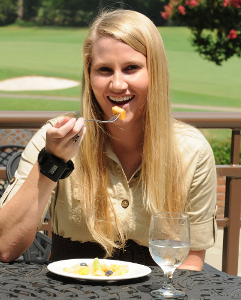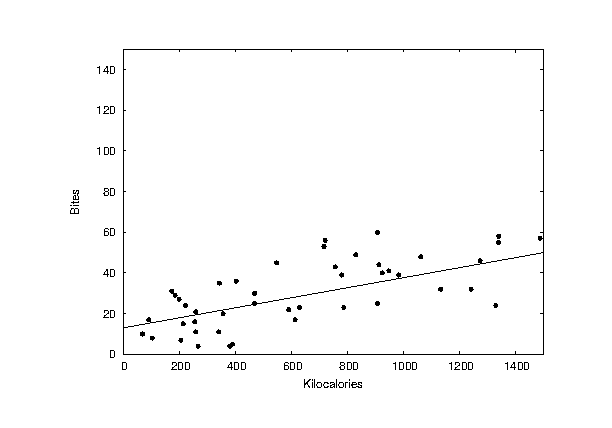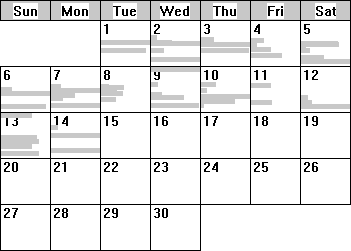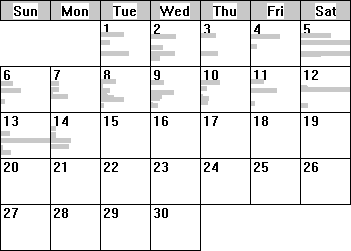Bite Counter Project
Device History
Over the years our device has matured from a sensor wired to a desktop
computer sitting next to the eater, to a fully self-contained device
manufactured by Bite Technologies,
to a free app available for both
Android
and
Apple
smartwatches.
Contact
Adam Hoover
if you are interested in hardware or research support.
 |
 |
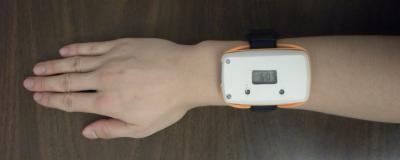 |
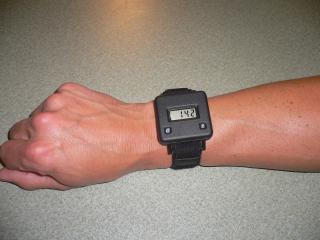 |
 |
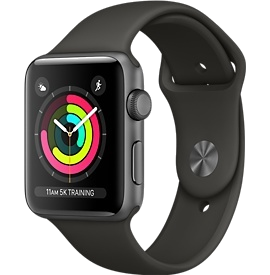 |
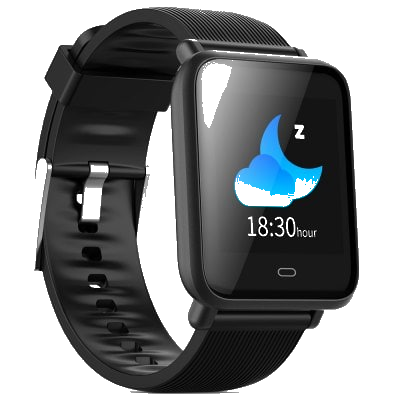 |
| Version 1 (2007). Tethered sensor. |
Version 2 (2008). Wireless sensor. |
Version 3 (2010). Self-contained unit, custom case. |
Version 4 (2011). Manufactured unit. |
Version 5 (2015). 2nd generation manufacturing. |
Version 6 (2017).
Apple smartwatch free app. |
Version 7 (2018).
Android smartwatch free app. |
Software
Desktop software for Windows can be downloaded here.
The software analyzes wrist motion data to detect eating episodes
(meals, snacks) and count the number of bites taken in each episode.
It is free and source code is included.
Obesity
Facts and health effects according to the
World Health Organization.
Real-time counters
showing there are nearly 3 times as many people suffering from
overfeeding than undernourishment in the world, along with the
associated medical costs.
A significant challenge is the development of
tools that can assist with the
measurement of energy expenditure and energy intake.
Technology
The Bite Counter device is worn like a watch and tracks wrist motion
during eating.
By detecting a characteristic pattern, it can identify when a bite
of food has been taken.
It can monitor intake in real-time and provide feedback to the wearer.
The feedback could tell the user to slow down, or
tell the user to stop eating after a target intake had been reached,
or help the user track long-term eating patterns.
The bite counter is a
tool
to help people track their intake.
Bites as a measure
The following graphs show data that relates bite count to calories.
Each data point is for one meal.
We tracked 83 people for 2 weeks, each graph shows all the meals for
a single person.
The data on the left show an approximately 0.4 correlation, while
the data on the right show an approximately 0.7 correlation.
Our study showed that most people correlate bites to calories
in this range.
Isn't a bite of carrots different from a bite of candy?
Of course.
But nobody gains or loses weight in a single bite, or even a
single meal. A common guideline is to lose a pound of weight per
week. Our hypothesis is that bite count can serve as a surrogate
for calorie count over a period of time. By automating the
counting process, and enabling it anywhere, any time, the bite
counter can empower individuals to better monitor intake.
As with calories, it is possible to count bites for a single meal;
but with either measure reduction goals are best evaluated over
at least a day.
Bite goals, like calorie goals, should be custom set to the individual.
This would be based not only upon the size, gender, age, and activity
level of the person, but also based upon the foods typically eaten.
For example, a vegetarian may have a higher bite count per day than
someone who regularly eats more energy-dense foods.
In addition, people tend to eat the same foods week to week.
Therefore, setting bite reduction goals over a period of time
has the same effect as setting calorie reduction goals.
Data
The Clemson Cafeteria data set was used for several of the experiments described in the below papers. It involves detecting bites within gyroscope/accelerometer signals.
Some multi-week datasets have been collected using bite counter devices and show a relationship between weight change and average daily bite count.
The data below are results of bite counting and
show 2 participants data for 2 weeks each.
The first participant shows a lot of late night eating activity.
The second participant shows increased consumption on weekends.
Click the images and links below to see example data files,
or download our software
to view it in calendar format.
Media
How to use a Bite Counter to measure eating intake for a meal
.
A laboratory demo of
a few bites, showing a signal-to-bite correlation.
Media about this research often appears
in the news.
Funding:
G. Thomas and S. Goldstein,
Microrandomized Trial to Optimize Use of Burden-reducing Self-monitoring Approaches in Behavioral Obesity Treatment,
National Institutes of Health, grant#
R01DK136216, 2024-2028.
-
A. Hoover and S. Goldstein,
Validating Sensor-based Approaches for Monitoring Eating Behavior and
Energy Intake by Accounting for Real-World Factors that Impact Accuracy
and Acceptability,
National Institutes of Health, grant#
R01DK135679, 2023-2027.
-
S. Goldstein,
Using Multimodal Real-Time Assessment to Phenotype Dietary Non-Adherence
Behaviors that Contribute to Poor Outcomes in Behavioral Obesity Treatment,
National Institutes of Health, grant#
R01DK132210, 2022-2027.
-
S. Goldstein,
Optimizing just-in-time adaptive intervention to improve dietary
adherence in behavioral obesity treatment: a micro-randomized trial,
National Institutes of Health, grant#
R01HL153543, 2020-2024.
-
A. Hoover, E. Muth and C. Martin,
Using Context to Validate and Improve Wrist-Tracking Measures of Eating Activity,
National Institutes of Health, grant#
R01HL118181,
2015-2019.
-
G. Turner-McGrievy,
Increasing Dietary Self-Monitoring and Weight Loss in an Mhealth Intervention,
National Institutes of Health, grant#
R21CA187929,
2015-2017.
-
A. Hoover and E. Muth,
Assessing the Bite Counter as a Tool for Food Intake Monitoring: Phase 2,
National Institutes of Health, grant#
R42DK091141,
2014-2017.
-
A. Hoover and E. Muth,
Assessing the Bite Counter as a Tool for Food Intake Monitoring,
National Institutes of Health, grant#
R41DK091141,
2011-2013.
-
E. Muth, A. Hoover and P. O'Neil,
South Carolina Clinical and Translational Institute,
2011.
-
A. Hoover and E. Muth,
South Carolina Launch,
2010.
Papers about this project:
-
Z. Tang, A. Patyk, S. Goldstein, J.G. Thomas and A. Hoover,
"Detecting Eating Episodes From Wrist Motion Using Daily Pattern Analysis",
in IEEE J. of Biomedical and Health Inforamtics, Dec 2023.
-
S. Goldstein, A. Hoover and J.G. Thomas,
"An explanation for the accuracy of sensor-based measures of energy intake: Amount of food consumed matters more than dietary composition",
in Appetite, vol. 194(1), pp. 107176, March 2024.
-
C. Popp, C. Wang, et. al.,
"Objective Determination of Eating Occasion Timing (OREO): Combining Self-Report, Wrist Motion, and Continuous Glucose Monitoring to Detect Eating Occasions in Adults With Pre-Diabetes and Obesity",
in J. of Diabetes Science and Technology, Sept 2023.
-
S. Goldstein, A. Hoover and J.G. Thomas,
"Combining passive eating monitoring and ecological momentary assessment to characterize dietary lapses from a lifestyle modification intervention",
in Appetite, vol. 175, pp. 106090, 2022.
-
A. Brown, et al.,
"Toward more rigorous and informative nutritional epidemiology: the rational space between dismissal and defense of the status quo",
in Critical Reviews in Food Science and Nutrition, vol. 63(18),
pp. 3150-3167, 2023.
-
S. Sharma and A. Hoover,
"Top-Down Detection of Eating Episodes by Analyzing Large Windows
of Wrist Motion Using a Convolutional Neural Network",
in MDPI Bioengineering, vol 9, no 70, 2022.
-
S. Sharma and A. Hoover,
"The Challenge of Metrics in Automated Dietary Monitoring as
Analysis Transitions from Small Data to Big Data",
in IEEE Int'l Conf on Bioinformatics and Biomedicine, pp. 2647-2653, 2020.
-
Y. Luktuke and A. Hoover,
"Segmentation and Recognition of Eating Gestures from
Wrist Motion using Deep Learning",
in IEEE Int'l Conf on Big Data, 2020.
-
S. Sharma, P. Jasper, E. Muth and A. Hoover,
"The impact of walking and resting on wrist motion for automated detection
of meals",
in ACM Transactions on Computing for Healthcare, 1(4), pp. 1-19, 2020.
-
A. Sharma and A. Hoover,
"A Study on Linear Acceleration of the Wrist During Free-living",
in the proc. of IEEE
Intl Conf on Bioinformatics and Biomedicine, Nov. 2019.
-
B. Lin and A. Hoover,
``A Comparison of Finger and Wrist Motion Tracking to Detect Bites during
Food Consumption'',
in IEEE Conference on Body
Sensor Networks, May 2019.
-
G. Turner-McGrievy, et. al.,
``Defining Adherence to Mobile Dietary Self-
Monitoring and Assessing Tracking Over Time:
Tracking at Least Two Eating Occasions per Day
Is Best Marker of Adherence within Two
Different Mobile Health Randomized Weight
Loss Interventions'',
in J. of the Academy of Nutrition and Dietetics, accepted March 2019.
-
A. Hoover,
"Tracking Wrist Motion to Measure Energy Intake",
invited talk at the
short course on Mathematical Sciences in Obesity,
sponsored by Indiana University, June 2019, Baltimore, MD.
-
A. Boutte at. al.,
"Comparing Changes in Diet Quality Between Two Technology-Based
Diet Tracking Devices",
in J. of Technology in Behavioural Science, vol. 4 no. 1, 2019, pp. 25-32.
-
J. Salley, A. Hoover and E. Muth,
"Between and Within Subjects Predictors of the Kilocalorie Content
of Bites of Food",
in J. of the Academy of Nutrition and Dietetics,
Feb 2019, pp. 1-9.
-
J. Alex, et. al.,
"Bite count rates in free-living individuals: new insights from a
portable sensor",
in BMC Nutrition, vol. 4 no. 23, 2018, pp. 23-28.
-
G. Turner-McGrievy, et. al.,
"The Dietary Intervention to Enhance Tracking with Mobile Devices
(DIET Mobile) Study: A 6-Month Randomized Weight Loss Trial",
in Obesity, vol. 25 no. 8, August 2017, pp. 1336-1342.
-
R. Mattfeld, E. Muth and A. Hoover,
"A comparison of bite size and BMI in a cafeteria setting",
in Physiology & Behavior, vol. 181, November 2017, pp. 38-42.
-
G. Turner-McGrievy, et. al.,
"Byte by Bite: Use of a mobile Bite Counter and weekly behavioral
challenges to promote weight loss",
in Smart Health, vol. 3, 2017, pp. 20-26.
-
D. Weathers, J. Siemens and S. Kopp,
"Tracking food intake as bites: Effects on cognitive
resources, eating enjoyment, and self control",
in Appetite, vol. 111 no. 1, April 2017, pp. 23-31.
-
Y. Shen, J. Salley, E. Muth and A. Hoover,
"Assessing the Accuracy of a Wrist Motion Tracking Method for
Counting Bites across Demographic and Food Variables",
in IEEE Journal of Biomedical and Health Informatics,
vol. 21 no. 3, March 2017, pp. 599-606.
-
S. Sharma, P. Jasper, E. Muth, and A. Hoover,
"Automatic Detection of Periods of Eating using Wrist Motion Tracking",
in the proc. of IEEE Conference on Connected Health: Applications,
Systems and Engineering Technologies, 2016, pp. 362-363.
-
Y. Shen, E. Muth and A. Hoover,
"Recognizing Eating Gestures Using Context Dependent Hidden Markov Models",
in the proc. of IEEE Conference on Connected Health: Applications,
Systems and Engineering Technologies, 2016, pp. 248-253.
-
A. Hoover,
"Bite measurement methods and models",
invited talk at the
Third short course on mathematical sciences in obesity research,
University of Alabama at Birmingham, June 2016, Birmingham, AL.
-
R. Mattfeld, E. Muth and A. Hoover,
"Measuring the consumption of individual solid and liquid bites
using a table embedded scale during unrestricted eating",
in IEEE Journal of Biomedical and Health Informatics,
vol. 21 no. 6, Nov 2017, pp. 1711-1718.
-
P. Jasper, M. James, A. Hoover and E. Muth,
"Effects of Bite Count Feedback from a Wearable Device and
Goal-Setting on Consumption in Young Adults",
in Journal of the Academy of Nutrition and Dietetics,
vol. 116 no. 11, pp. 1785-1793.
-
J. Salley, A. Hoover, M. Wilson and E. Muth,
"A Comparison Between Human and Bite-Based Methods of Estimating Caloric
Intake",
in Journal of the Academy of Nutrition and Dietetics,
vol. 116 no. 10, Oct 2016, pp. 1568-1577.
-
A. Hoover,
"Tracking Wrist Motion to Monitor Energy Intake",
invited talk at the
Second short course on mathematical sciences in obesity research,
University of Alabama at Birmingham, June 2015, Birmingham, AL.
-
A. Hoover,
"Monitoring Human Energy Intake",
invited talk at
Bringham Young University,
April 2015, Provo, UT.
-
R Ramos, E. Muth, J. Gowdy and A. Hoover,
"Improving the Recognition of Eating Gestures
Using Inter-Gesture Sequential Dependencies",
in IEEE Journal of Biomedical and Health Informatics,
vol. 19 no. 3, May 2015, pp. 825-831.
-
A. Hoover,
"Tracking Wrist Motion to Monitor Energy Intake",
invited talk at the
Wireless Health 2013 conference,
Johns Hopkins University, November 2013, Baltimore, MD.
-
R Ramos and A. Hoover,
"A study of temporal action sequencing during consumption of a meal",
in the proc. of ACM Conf. on Bioinformatics,
Computational Biology and Biomedical Informatics, Sept 2013, Washington DC.
-
Y. Dong, J. Scisco, M. Wilson, E. Muth and A. Hoover,
"Detecting Periods of Eating During Free-Living by Tracking Wrist Motion",
in IEEE Journal of Biomedical and Health Informatics,
vol. 18 no. 4, July 2014, pp. 1253-1260.
-
J. Scisco, E. Muth and A. Hoover,
"Examining the Utility of a Bite-Count Based Measure of Eating
Activity in Free-Living Humans",
in Journal of the Academy of Nutrition and Dietetics,
vol. 114 no. 3, April 2014, pp. 464-469.
-
J. Salley, J. Scisco, E. Muth and A. Hoover,
"A Comparison of User Preferences and Reported Compliance with the
Bite Counter and the 24-Hour Dietary Recall",
in proc. of Human Factors and Ergonomics Society Annual meeting, 2012.
-
Y. Dong, A. Hoover, J. Scisco and E. Muth,
"A New Method for Measuring Meal Intake in Humans via
Automated Wrist Motion Tracking",
in Applied Psychophysiology and Biofeedback,
vol 37, no 3, 2012, pp 205-215.
-
Y. Dong,
"Tracking Wrist Motion to Detect and Measure the Eating
Consumption of Free-Living Humans'',
PhD dissertation, Electrical & Computer Engineering Department,
Clemson University, May 2012.
-
J. Scisco,
"Sources of Variance in Bite Count",
PhD dissertation, Psychology Department,
Clemson University, May 2012.
-
J. Scisco, E. Muth, Y. Dong, A. Hoover,
"Slowing bite-rate reduces caloric consumption; an application of
the bite counter device", in Journal of the American Dietetic
Assocation, vol. 111, 2011, pp. 1231-1235.
-
Y. Dong, A. Hoover, J. Scisco and E. Muth,
"Detecting Eating Using a Wrist Mounted Device During
Normal Daily Activities",
in the proc. of WorldComp, 2011.
-
A. Hoover, E. Muth and Y. Dong,
"Weight Control Device Using Bites Detection",
US Patent no 8310368, filed January 2009, granted November 2012.
-
Y. Dong, A. Hoover and E. Muth,
"A Device for Detecting and Counting Bites of Food
Taken by a Person During Eating",
in the proc. of IEEE International Conference on Bioinformatics
and Biomedicine, 2009.
Bite Counter Project Page / Clemson / ahoover@clemson.edu















